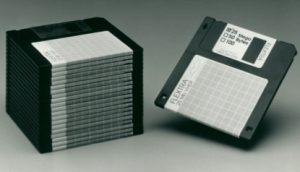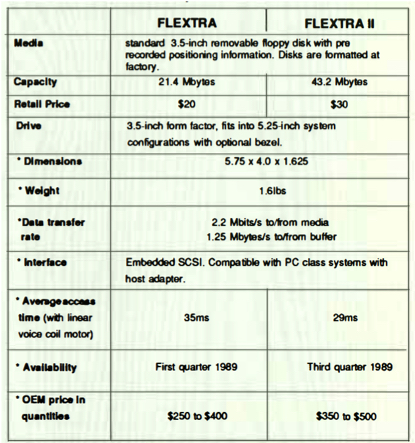History (1988): Brier Technology Packs 50MB on Standard 3.5-Inch FDD
Using varying number of data sectors per track
By Jean Jacques Maleval | June 17, 2019 at 2:19 pmBrier Technology (San Jose, CA) was founded in April 1986 by 5 people:
- John F. Bizjak, CEO and president, who was VP of Data Technology Corp.;
- L. Roy Shenfield, VP product development, who was also formerly to DTC;
- Jack R. Taylor, VP marketing and sales, who was a co-founder of Ultradisc Corp., a manufacturer of thin-film disk;
- Raymond Niedzwiecki, VP operations, who co-founded Maxtor and Dimeco International; and
- the fifth one is John Sullivan.
Brier is a private-held company, its major investor being Intelligent Systems MLP.
The new technology used to boost the capacity of standard 3.5-inch diskettes is named T3 or Twin Tier Tracking.
It uses two distinct horizontal magnetic layers in the disk media. The lower or positioning tier, consisting of thousands of magnetically embedded, prerecorded positioning tracks, precisely read/write heads of the drive. The upper or data tier is a smoot hungrooved surface on which the user’s data is stored in magnetic tracks. Since none of the upper surface is needed for head-positioning tasks, Brier’s data tracks use the complete surface of the diskettes. The twin tracking tiers, while transparent to the user, provide an access time of around 30ms. Unlike conventional floppy or Winchester disk arrangements which use concentric circles with the same number of data sectors per track, Brier uses a varying number of data sectors per track, each of uniform sector size. Tracks on the outer surfaces of the disk contain 48 data sectors while those closer to the center of the diskette contain 32 sectors.
Brier announces that T3 technology offers buih-in upward mobility to 50MB or even 100MB 3.5-inch floppy disk drives without requiring alteration of the diskette’s FDDtrack tier.
The magnetically embedded lower tier contains all of the positioning tracks needed for 25MB, 50MB or higher density diskettes.
For the 25MB, Brier uses 777 data tracks per inch, roughly one in every eight of the lower positioning tracks.
Higher capacity drives use a proportionally greater number of the pre-recorded positioning tracks. Changes in the read/write head of the disk accomplish this task without modifying the basic tracking technology or physically alterating the media.
These high capacity floppy disk drives fit directly into a standard 3.5-inch half-high slot or can be adapted for use in a 5.25-inch slotor as a stand-alone unit.
The drives feature the industry standard intelligent SCSI interface with integrated controller.
They employ a linear voice-coil motor instead of the stepper motor used in conventional drives.
A proprietary Flexcorder system embeds the T3 on an industry standard 3.5-inch flexible media before the diskettes are distributed to customers.

With an expected retail price of $20 or $30, basically 10 to 15 times more than a plain diskette, Brier provides an alternative for high-capacity storage previously available only in fixed disk systems.
The company offers two models of drives.
The first one, named Flextra, can record up to 21.4MB formatted with a 35ms average access time. It will cost $250 to$400 in OEM quantities when it will be available, in 1Q89 according to the company.
The next one, called Flextra II ($350 to $500), will have a 43.2MB formatted capacity and a 29ms access time.

Irwin Magnetic Systems, Inc. (AnnHarbor, MI) has signed a license agreement to second source Brier’s 25MB FD and FDD.
Plans are also underway to license a major manufacturer of media to pre-record and distribute the diskettes.
This article is an abstract of news published on the former paper version of Computer Data Storage Newsletter on issue ≠11, volume ≠1, published on November 1988.














 Subscribe to our free daily newsletter
Subscribe to our free daily newsletter

